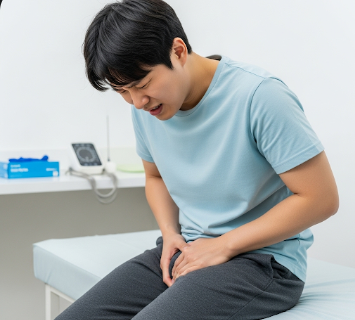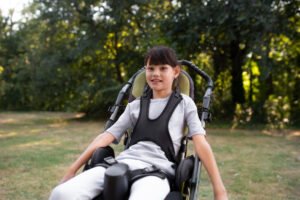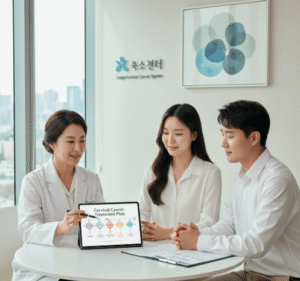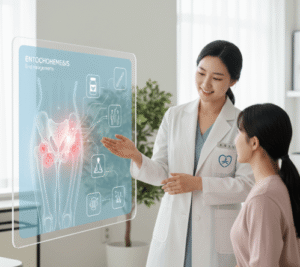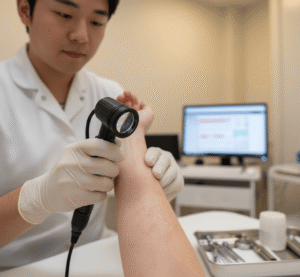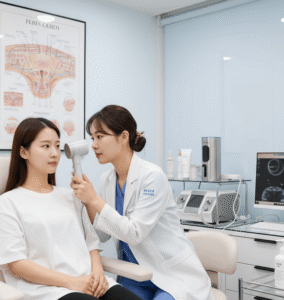Overview
Groin pain is a common symptom that refers to discomfort or aching felt in the area where the abdomen meets the thigh, near the inner hip joint. This region contains muscles, tendons, ligaments, lymph nodes, and reproductive organs, so pain in the groin can have multiple causes ranging from muscle strain to more serious conditions such as hernia, kidney stones, or even hip joint disorders.
Both men and women can experience groin pain, though some causes differ by gender. For instance, men may develop groin pain due to testicular conditions, while women may experience it as part of gynecological disorders. In athletes, groin pain is often linked to muscle injuries or sports hernias.
In South Korea, advanced diagnostic imaging and specialized orthopedic, urologic, and gynecologic care allow for highly accurate diagnosis and effective treatment of groin pain, tailored to the underlying cause.
Key Facts
➲ Groin pain can result from muscle injuries, hernias, urinary, or reproductive disorders.
➲ Athletes commonly experience groin strains due to overuse or sudden movement.
➲ In men, groin pain may indicate testicular problems; in women, it may relate to ovarian or pelvic conditions.
➲ Pain that radiates to the back or abdomen may signal kidney stones or hip issues.
➲ Persistent or severe groin pain should be evaluated by a doctor to rule out serious underlying conditions.
➲ In Korea, patients benefit from cutting-edge imaging and minimally invasive treatments.
What is Groin Pain?
Groin pain is defined as discomfort localized to the crease where the thigh meets the abdomen. It may be sharp, dull, intermittent, or constant, depending on the cause. The pain may radiate to nearby areas such as the inner thigh, lower abdomen, hip, or genitals.
It can be acute (sudden onset after injury) or chronic (lasting more than a few weeks). Chronic groin pain is common in athletes and individuals with hip joint disorders.
What Symptoms Are Related to Groin Pain?
Groin pain is often accompanied by other signs depending on its cause:
➲ Muscle tenderness, swelling, or bruising after injury.
➲ Pain that worsens with movement or physical activity.
➲ A bulge in the groin (possible hernia).
➲ Testicular pain or swelling (in men).
➲ Menstrual irregularities or pelvic pain (in women).
➲ Pain radiating to the lower back, buttocks, or legs.
➲ Difficulty walking or reduced range of hip movement.
➲ Burning sensation while urinating (possible urinary infection).
What Causes / Possible Causes
Groin pain has a variety of potential causes, which can be classified into categories:
1. Musculoskeletal Causes
➲ Muscle strain or tear (especially adductor muscles in athletes).
➲ Tendinitis or ligament sprains.
➲ Sports hernia (weakened abdominal wall in athletes).
➲ Hip disorders such as labral tears, arthritis, or femoroacetabular impingement.
2. Reproductive System Causes
➲ In men: testicular torsion, epididymitis, orchitis, varicocele.
➲ In women: ovarian cysts, pelvic inflammatory disease, ectopic pregnancy, endometriosis.
3. Urinary Tract Causes
➲ Kidney stones causing radiating pain into the groin.
➲ Urinary tract infections (UTIs).
➲ Bladder conditions.
4. Hernias
➲ Inguinal hernia is one of the most common causes, where abdominal tissue pushes through the abdominal wall into the groin.
5. Other Causes
➲ Enlarged lymph nodes due to infection or cancer.
➲ Nerve compression or sciatica radiating into the groin.
➲ Trauma or direct injury.
When Should I See My Doctor?
You should seek medical care if:
➲ The pain is sudden and severe, especially with testicular involvement.
➲ There is a visible bulge in the groin that worsens with coughing or straining.
➲ Pain is accompanied by fever, nausea, or vomiting.
➲ You experience blood in urine or painful urination.
➲ Pain persists for more than a week without improvement.
➲ You are unable to walk, bear weight, or move your hip.
Emergency care is required for suspected testicular torsion, incarcerated hernia, or severe trauma, as these can be life-threatening or cause permanent damage.
Care and Treatment
The approach to managing groin pain depends on its underlying cause.
Self-Care and Home Management
➲ Rest and avoid activities that worsen the pain.
➲ Apply ice packs to reduce swelling and pain after an acute injury.
➲ Use heat therapy for chronic muscle tightness.
➲ Gentle stretching and strengthening exercises (if musculoskeletal).
Medications
➲ Non-steroidal anti-inflammatory drugs (NSAIDs) for pain and inflammation.
➲ Antibiotics for urinary or reproductive tract infections.
➲ Muscle relaxants for spasms.
➲ Hormonal therapy for certain gynecological conditions.
Medical Procedures
➲ Hernia repair surgery if a hernia is confirmed.
➲ Lithotripsy or ureteroscopy for kidney stones.
➲ Arthroscopy or joint surgery for hip disorders.
➲ Drainage of abscesses if infection is present.
Rehabilitation
➲ Physical therapy to restore mobility and prevent recurrence.
➲ Gradual return-to-sport programs for athletes.
➲ Lifestyle changes such as weight management to reduce pressure on the hip and groin.
Treatment Options in Korea
South Korea offers world-class medical facilities with advanced diagnostic and treatment options for groin pain.
Diagnosis in Korea
➲ High-resolution ultrasound to detect hernias, cysts, or muscle injuries.
➲ MRI and CT scans for hip joint and soft tissue evaluation.
➲ Specialized urologic and gynecologic tests for reproductive system disorders.
➲ Urinalysis and kidney function tests for urinary causes.
Medical Treatments in Korea
➲ Precision pain management with targeted medications.
➲ Minimally invasive laparoscopic surgery for hernias.
➲ Advanced lithotripsy for kidney stone removal.
➲ Modern antibiotics and fertility-preserving therapies for infections.
Surgical and Advanced Therapies
➲ Robotic-assisted hernia repairs with faster recovery.
➲ Hip-preserving arthroscopic surgery for athletes.
➲ Specialized women’s health clinics for ovarian and pelvic conditions.
➲ Urology centers focusing on male reproductive causes.
Rehabilitation and Support
➲ Individualized physiotherapy programs for athletes and active individuals.
➲ Sports rehabilitation centers in Seoul and Busan.
➲ Integrative treatment plans combining medicine, exercise, and nutrition.

